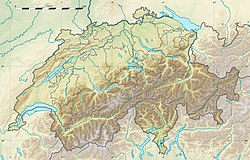| Schrattenkalk Formation | |
|---|---|
| Stratigraphic range: Barremian-Aptian | |
 Schrattenkalk in Luzern, Switzerland | |
| Type | Geological formation |
| Sub-units | Lower Schrattenkalk, Rawil Member, Upper Schrattenkalk |
| Underlies | Garschella Formation |
| Overlies | Tierwis Formation |
| Thickness | up to 300 m (980 ft) |
| Lithology | |
| Primary | Limestone |
| Other | Sandstone, mudstone |
| Location | |
| Coordinates | 46°58′30″N8°19′49″E / 46.9751°N 8.3303°E |
| Approximate paleocoordinates | 31°36′N18°30′E / 31.6°N 18.5°E |
| Region | Alps |
| Country | Austria, Germany, Switzerland |
| Type section | |
| Named for | Schrattenfluh |
| Named by | Bernhard Studer |
| Year defined | 1834 |
The Schrattenkalk Formation is a Barremian to Aptian geologic formation in the Alps. The limestone is highly karstified. Fossil ornithopod tracks have been reported from the formation. [1] Iguanodont tracks have been registered in the Swiss portion of the formation. [2] The famous north face of the Eiger is partly composed of Schrattenkalk, [3] as well as the Sturmannshöhle in southernmost Bavaria, Germany, [4] and the Hölloch (second-longest cave in Europe) and Silberen system karst caves in Switzerland. [5]

